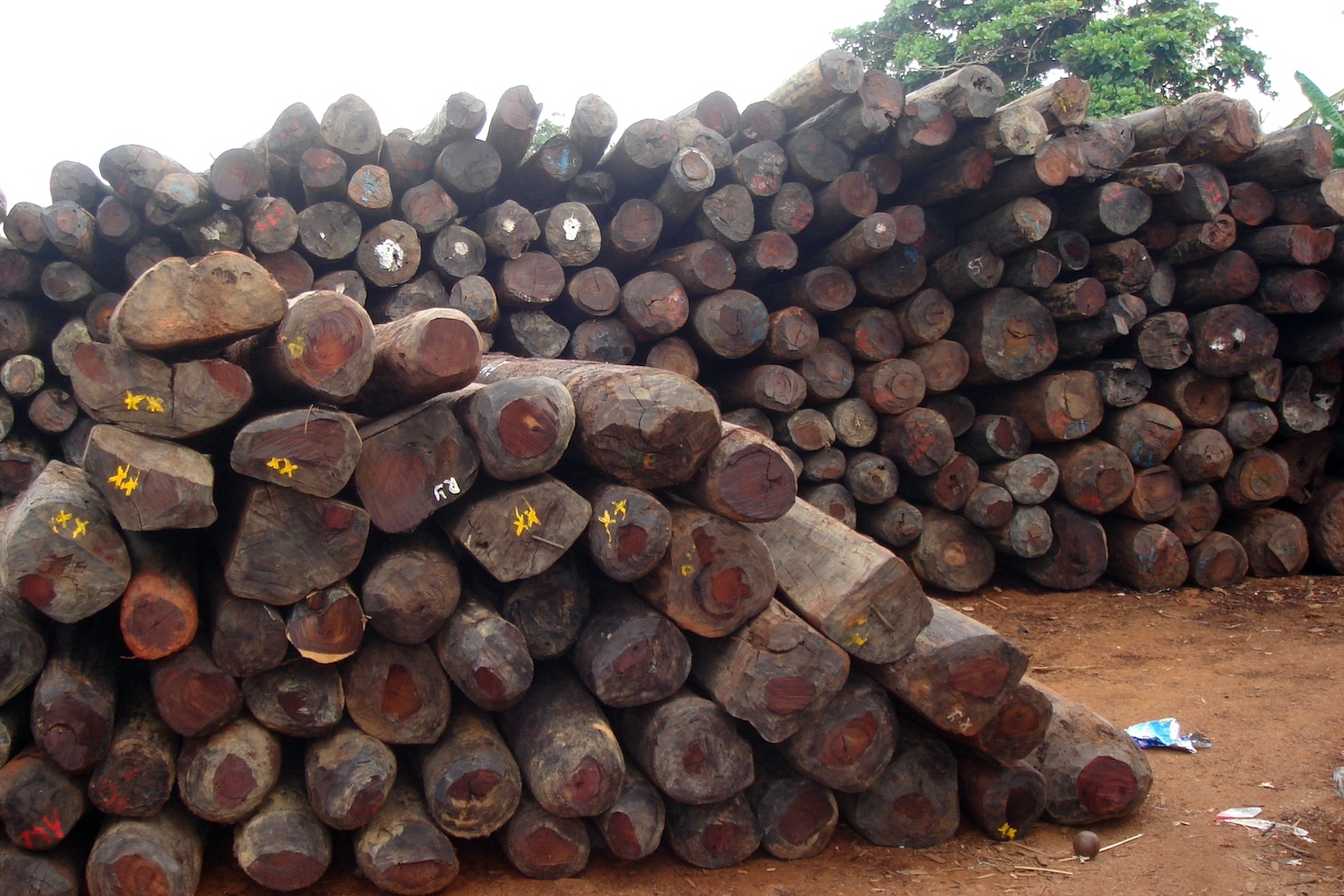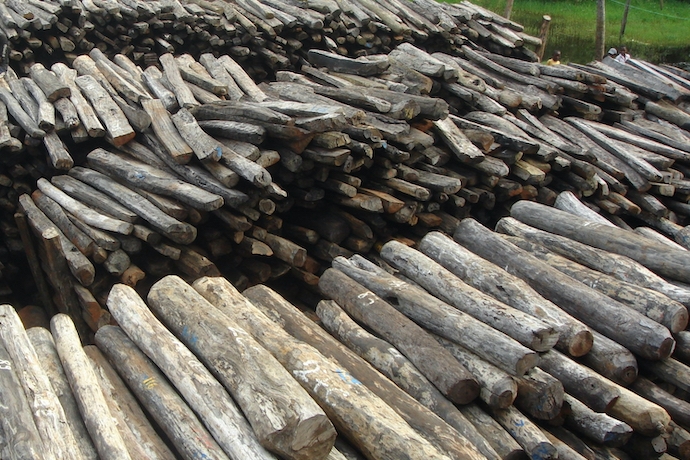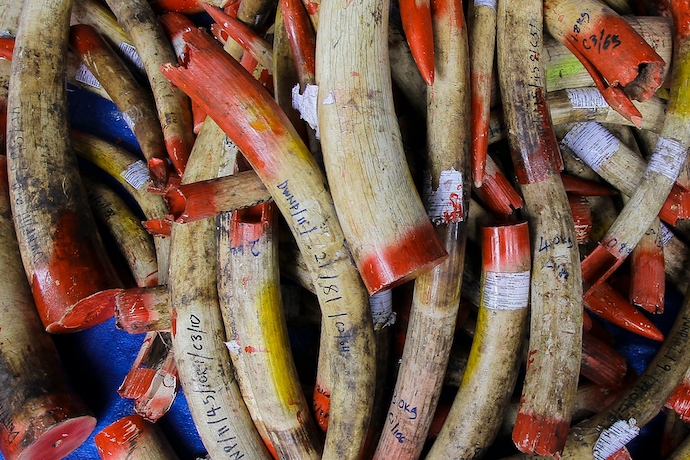
Blundered Verdict by Kenyan Court Releases Seizure Back to Smugglers
It does not happen often that a criminal network uses the legal system to retrieve its contraband investment. But that is exactly what occurred in a Mombasa court on November 18th, when Hong Kong’s Shihua Industry Alliance Co. Ltd. finally won its legal release from the Kenyan Revenue Authority (KRA).
It should have been a national embarrassment. A Chief Magistrates Civil Court followed by an Appeal Court providing judicial authorisation to return 646 tonnes of smuggled Malagasy rosewood, worth $13 million dollars, to the criminal organization that took it. But then again, perhaps not. Despite Kenya’s internationally recognised and resolute stance against illegal wildlife crime, its conviction record in major wildlife cases stands at zero. The Appeal Court even twisted the knife further by awarding costs to the smuggler.
The first thought of many would-be ‘corruption.’ Corruption had been clearly evident throughout the trial of ivory trafficker Feisal Mohamed Ali and the extradition process of drug dealers Baktash and Ibrahim Akasha.
This Mombasa rosewood seizure is believed to have been the biggest flora and fauna seizure made in Kenya, by weight and monetary value. The Kenya Wildlife Service, the designated national authority for the management of all matters related to CITES (Convention on International Trade in Endangered Species of Wild Fauna and Flora) in Kenya, whose intelligence led to the seizure, believed that the rosewood was illegal at the time it was offloaded in Mombasa port for transshipment to Hong Kong. Likewise, the Kenya Forest Service (KFS), the Directorate of Criminal investigations (DCI), the KRA, and the Office of the Director of Public Prosecutions (ODPP) were of a similar belief. The courts felt that it was not. The primary point of contention was whether Malagasy rosewood Dalbergia spp, at the time of the seizure, was listed on CITES Appendix II or Appendix III.
But this seizure and ensuing court action were far more complex than one primary point of contention.
No criminal prosecution
There was never a criminal prosecution in this matter. DCI Kilindini (Mombasa Port police) did open an investigative file, but no person or business entity has been charged to date. The court action was all civil, with the smugglers initiating four separate applications for the return of ‘their’ wood. Perhaps that was the investigative tactic from the beginning. Let the owner come to us.
It was 89 months between the date of seizure to the day when the KRA furnished Shihua Industry Alliance its unconditional release. The investigation and subsequent court processes involved all the previously mentioned government agencies while also including the office of the Honourable Attorney General and the County Conservator (Mombasa). The court file, as massive as it became, went through the hands of three Magistrates and three Justices.
Not typical of a criminal trial, much of the evidence in these civil applications was submitted to the courts through written affidavits and submissions. Oral testimony was minimal. As such, it is difficult to ascertain with certainty what evidence was adduced to the court. However, the detail in the initial judgment and the subsequent appeal does present the facts on which the final contraband release was based.

Three other rosewood seizures
In the first five months of 2014, four large seizures of Malagasy rosewood were affected in four different ports. Three of those seizures transited Zanzibar. On February 14th, 2014, authorities in Zanzibar seized six containers of rosewood (781 logs) from a shipment en route to Hong Kong. By all accounts, there was a further 1,996 rosewood logs from that consignment that ‘somehow’ made it through the net. Coincidentally, the involved ship that was carrying the rosewood, MV Bravo, was also carrying a container with 1 tonne of ivory that had been loaded at Mombasa. The case is still in the Mombasa courts.
One month later, on March 17th, a massive shipment of rosewood was seized in Singapore. Authorities seized 30,650 Malagasy rosewood logs weighing 3,372 tonnes.
On April 2, 420 tonnes (3,669 logs) of Malagasy rosewood in 28 containers were seized in Sri Lanka. The shipment, valued then at $7.6 million, originated (on paper) in Zanzibar on March 2nd. Hong Kong was likewise the destination of this shipment.
MV’s Miltzow, Muneera, and Kota Hapas
On May 19th, 2014, the records show that the vessel, MV Kota Hapas, docked at Mombasa Port, berth 4-5 at 17:36 hrs. Four hours later, it was discharging the 34 containers of smuggled rosewood for transshipment. They were the only containers to come off the MV Kota Hapas.
KWS had already received information that these containers were full of illegal rosewood from Madagascar. Over the course of two days, May 26th to May 29th, the 34 containers were verified by a multi-agency group consisting of KWS, DCI, KRA, the Kenya Port Authority (KPA), and a representative of the involved shipping line, Pacific International Lines (PIL). All 34 containers were found to be containing what was believed to be Malagasy rosewood Dalbergia spp.
Accompanying documents indicated that the consignor was Andriamahafaly Manitra, a Madagascar business exporting to a Hong Kong consignee, HK Minghantang Wood Industry International Company Ltd. These documents also included a certificate of origin seemingly issued by the Madagascar Ministry of Forestry and Environment certifying that a consignment of 7,100 pieces of wood was of Malagasy origin. While the form was dated April 1st, there is nothing that would indicate that the certificate referred specifically to the 34 containers. It also did not list the consignee. No CITES permits were produced because the position of the consignor, clearing agent, and consignee, was that the shipment consisted of ordinary wood.
The KRA C17 customs entry documents pertaining to the shipment also indicated that the consignment consisted of ordinary wood. But there were significant differences. The consignor was listed as PIL Zanzibar and not Andriamahafaly Manitra. The consignee was not HK Minghantang Wood Industry International Company Ltd but Shihua Industry Alliance Co. Ltd. of Hong Kong (25 containers) and ZH Leung HK Trading Ltd. (9 containers). Each of the four customs forms indicated 300 pieces of ordinary wood for a consignment total of 1,200 pieces while the certificate of origin stated 7,100 pieces. This customs form information was in concert, however, with the manifest and bills of lading, all indicating the journey began in Zanzibar on the PIL vessel, MV Kota Hapas.
But this journey did not commence in Zanzibar or on the MV Kota Hapas. Based on information taken from 2014 press briefings of the KRA and the KWS, a KPA Mombasa port schedule of April 2014, and a statement of the operations assistant of PIL Shipping Mombasa, the following can be pieced together.
The rosewood from Madagascar was loaded on the vessels MV Miltzow and MV Muneera en route for Mombasa. Both ships had previously been in the international spotlight in 2005 having been hijacked by Somali pirates. The Muneera was named the MV Semlow at the time and both ships were owned by a Mombasa shipping company, the Mutoka Shipping Agency.
They were scheduled to arrive in Mombasa port on April 12th and 14th, carrying 400 log pieces and 100 pieces respectively. The ships did not arrive. They docked instead at Zanzibar where the wood was offloaded into primarily PIL containers and then onto MV Kota Hapas. At that time, the Kota Hapas was plying between only four ports: Mombasa, Dar es Salaam, Zanzibar, and Karachi. Indeed, the Kota Hapas left Mombasa for Karachi on May 23rd.
A 2014 report by the Environmental Investigation Agency entitled: “The Ongoing Illegal Logging Crisis in Madagascar – An EIA Briefing for CITES SC65,” provided the reasoning behind the modus operandi. Chinese smugglers in Madagascar used offshore transit vessels to shuttle the wood to Zanzibar where the wood was loaded directly into shipping containers. The containers would then be put on legitimate ships with a destination of Hong Kong, often transhipped to other destinations to mask the place of origin. This EIA report provided three case studies as examples. The Mombasa seizure was one of them.

The meetings at the Castle Royal Hotel
Three months into the investigation no arrests had been made by DCI Kilindini. DCI Kilindini had the investigative lead in this case, not KWS. For a brief period, an undercover operative with an investigative NGO was injected into the investigation to assist. Subsequent surveillance led to an observed meeting at Mombasa’s Castle Royal Hotel on August 28th, 2014, between three men.
Abdulrahman Mohamed Agil was the clearing agent involved and had been contracted by PIL Shipping to facilitate the transshipment process through Mombasa Port. The Operations Manager of PIL Shipping Mombasa was also there as well as a Chinese national, Zhong Gui Li, who identified himself as representing the owner of the rosewood. He had arrived from Madagascar three days previous and informed the others he was there, not only to negotiate for the release of the rosewood but to also facilitate the shipment of other rosewood, left behind in Zanzibar. Agil requested and advised him that $600,000 would be required to bribe officials for the release. Zhong Gui Li said that paperwork would be forthcoming from Madagascar to permit the release. The bulk of the conversation was between Agil and the Chinese national.
A second meeting took place the next day at the same hotel between Agil and Li. During this conversation, Li told Agil that he had tried to obtain the release of the wood one month previous through a Somali broker who purportedly had State House contacts. That attempt did not succeed. Agil, to demonstrate the work he had done to date, presented four completed but unsigned C17 customs forms to Li. The forms each had a different entry number and pertained to all the 34 containers that had been seized. Agil’s name was on the forms as the involved agent. Shihua Industry Alliance was listed as the consignee on three and ZH Leung on the fourth. The consignment was described as ordinary wood. Agil requested an advance on the $600,000, adding that as the containers were beside the port police station, they would also need a bribe.
It was agreed that the two would meet again with a lawyer to sign a contract on August 30th, but that meeting did not happen. It is not known if the meeting ever took place as the investigative NGO’s involvement concluded. Li remained in Mombasa until September 25th at which time he flew back to Madagascar.
It was a common investigative practice at the time for DCI to charge clearing agents involved in seized shipments of contraband goods. This has been seen in a number of ivory-related seizures in Mombasa. Agil was not charged despite his apparent knowledge relating to the rosewood and making a false declaration on the customs forms. He did provide two separate witness statements to police in 2014 and in 2016 as well as a sworn affidavit that was included in the application that launched the civil suit of Shihua Industry Alliance in 2017.
PIL Shipping (Kenya) was also initially listed as a suspect. This was not the first time that they had been linked to contraband shipments, being the shipping line utilised by ivory traffickers in two Mombasa seizures in July 2013.
The back door
The owners of the illegal rosewood, now apparently Shihua Industry Alliance and/or ZH Leung Trading of Hong Kong had a problem. If they went to the DCI investigators to inquire about the retrieval of their shipment, they were going to be arrested and charged. After all, they knew they were shipping illegal rosewood.
Consequently, they opted to go through the courts with a civil action thereby never having to attend or speak directly with the police or KRA. A Kenyan national, Salma S. Mbauro, an apparent employee of the obscure Yutuna Shipping Line of Mombasa became the owner’s agent. All required affidavits for the courts and on behalf of Shihua Industry Alliance or ZH Leung Trading were subsequently filed by her.
The first court action, however, was initiated in May 2015 by the Zanzibar clearing and forwarding agent who had an involvement in the shipment prior to its Mombasa arrival. Visiwani Enterprises Clearing and Forwarding were the plaintiffs in Mombasa civil suit 660 of 2015 against the KRA, applying for the release of the 34 containers. That court did order the release but upon learning of such, the ODPP successfully intervened and the order was vacated.
Two years passed and in November 2017, Shihua Industry Alliance and ZH Leung Trading launched separate actions through the sworn affidavit of Salma Mbauro. Each company indicated an interest in 17 of the containers. The two applications, 328/2017 and 329/2017 were consolidated into one, with the applicants (Shihua and ZH Leung) requesting a forensic audit of the wood, a return of the consignment, and legal costs are provided. Their request for the forensic audit was curious as Shihua’s position up to this point was that their shipment consisted of ordinary wood and all documents availed through investigation also indicated as such.
The analysis of the wood was conducted by the National Museums of Kenya (NNM) – Centre of BioDiversity. They also conduct analyses of seized ivory in wildlife trophy prosecutions. To the surprise of no one, the NNM report of March 2, 2018, indicated that the wood seized was rosewood Dalbergia spp.
The judgment and appeal
The initial judgment in favour of the Shihua Industry Alliance was made in Chief Magistrate’s Civil Court by Senior Resident Magistrate Eric Mutunga in November 2018. KWS launched an immediate appeal on the grounds that the court had erred in law and fact on a number of issues. In August 2019, and now referred to as Civil Appeal 23 0f 2019, of the Environment and Land Court Mombasa, Justice Anne Omollo upheld the lower court decision stating: “I find the appeal filed lacking in merit. I dismiss it with costs to the first respondent (Shihua) to be borne by the Appellant (KWS).”
In a partial defence to Justice Omollo, she was never availed the lower court’s considerable file despite a request to do so. She, therefore, based her decision on documents submitted by the involved parties and her interpretation of CITES regulations.
Both judgments centred primarily on two points. SRM Mutunga wrote: “the species named was still under Appendix III of CITES, an issue that is not in dispute from all parties herein…and was only classified under CITES Appendix II on 4 October 2017.” Justice Omollo adopted the same position.
This statement was wrong on two counts. First, all parties were not in agreement that Dalbergia spp was on Appendix III prior to or at the time of seizure. The position of KWS, KFS, and ODPP, and indeed the primary point of contention in this action, was that at the time of the seizure, Malagasy Dalbergia spp was on Appendix II. As such, it was impossible to transport without a CITES export permit. Such a permit could not have been issued legally as Madagascar passed a law making it a violation to export Dalbergia spp as of March 24th, 2010. It was also on CITES Appendix II.
Both SRM Mutunga and Justice Omollo, however, read it differently. Justice Omollo went into detail, dedicating six of the 15 paragraphs of her decision to why Malagasy rosewood was on Appendix III at the time of seizure, even quoting a paragraph of Decision 16.152 of the 16th COP. In one of those paragraphs, the Honourable Magistrate wrote that rosewood was not operationalised to Appendix II until January 2017. To even the relatively well-informed, she presented what appeared to be a forceful and factual argument. But she, and SRM Mutunga, were wrong.
All species of rosewood from Madagascar, in log, sawn, or veneer forms were placed on CITES Appendix II, operationally, on June 12th, 2013. This comes from the decision made at COP16, 90 days previous. The listing to which Justice Omollo referred applied to the Dalbergia spp genus as a whole, not Malagasy Dalbergia spp, that was already listed.
The ramifications of such listing meant that Malagasy rosewood Dalbergia spp could not be exported without permit documents from the CITES authorities of the country of origin. On April 1st, 2014, if that is the date on which the rosewood left Madagascar, it was not only contrary to CITES criteria, but it was also illegal under Madagascar law. When it arrived in Mombasa on May 19th, it also violated the Wildlife Conservation and Management Act (2013) of Kenya.
Further restrictions had been placed on this shipment and six other international seizures as identified in the 2016 CITES document, “Report of Madagascar” SC66 Doc.46.2. Paragraph 32 of that report detailed how seven rosewood seizures that had been made outside Madagascar and were “illegal under Malagasy law because they have been smuggled out of the country during periods in which exports were banned.” The Mombasa seizure was listed under subparagraph (f).
The second point of contention in the respective judgments revolved around the shipping permits that had been annexed to the original affidavit submission of Ms. Mbauro on behalf of Shihua. It was stated that KWS had not provided the court with evidence to impugn the validity of those permits.
So what of the DCI, who were the lead investigators in this seizure and had the evidence to impugn the validity of the produced ‘permits’? While both judgments make reference to affidavits from Shihua (Mbauro), KWS, and KFS, there is no referral to the affidavit of Police Constable Kennedy Opiti of DCI Kilindini.
On June 6th, 2014, Mbauro had produced two documents to a DCI investigator on behalf of the Shihua Alliance Industries indicating that the wood originated from Mozambique. On June 17th, the same DCI investigator retrieved from the offices of PIL Shipping, five documents indicating that the “ordinary wood” had come from Madagascar. One of those five documents named Shihua Alliance Industries as the consignee.
The DCI was also aware of “the meetings” at the Castle Royal Hotel of 2014 when Zhong Gui Li of Shihua, the clearing agent, Abdulrahman Mohamed Agil, and a PIL Shipping representative sat together at the same table and discussed the shipment and bribes required to release the contraband.
The denouement
The Mombasa courts had erred in law and fact, not once, but twice. There was an option for further appeal but that path was not taken for reasons unknown. Despite that, the case did not end there. Two further years of legal wrangling ensued between the courts, Shihua, KWS, DCI, and KRA as to who had the authority to grant the final release of the rosewood. The officer in charge of the Kenya Wildlife Service Mombasa, was in 2020 found to be in contempt of court before all agreed that it was the KRA with final release authority. This release was further delayed when Shihua requested that the rosewood be taken out of the 34 x 20-foot containers and placed in 22 x 40-foot containers, a process known as cross shipping.
The final twist came when the KRA presented an invoice to Shihua for $550,000 for seven years of back warehouse rent. The Cabinet Secretary for Treasury and Planning had to intervene. Unbelievably, the final shipping documents furnished for the court for the planned export of the Malagasy rosewood were still mis-declared as “ordinary wood” and African timber logs. An argument could be made that the courts by virtue of that sanction, became a party to the offence.
The news of the judicially released contraband reached the Environmental Investigation Agency (EIA) who had some early involvement in the 2014 investigation. Inquiries and consultations began at several different levels while the rosewood sat within Mombasa port awaiting departure.
On January 20th, CITES officially became involved. They had seen this before when in April 2019, the Singapore courts acquitted the businessman charged in relation to the over 3,000 tonnes of Madagascar rosewood seized there in 2014. Singapore had also ordered that rosewood returned.
CITES posted an advisory entitled “Current status of Malagasy rosewood logs seized by Kenya in May 2014 and advisory on rosewood stockpile originating from Madagascar”. Paragraphs three through five stated: “these rosewood logs had been illegally exported…it is feared that the stockpile in question is being traded illegally…CITES invited Parties to communicate any information regarding the export, transit, import or re-export of rosewood originating from Madagascar.”
The 640-tonne shipment of Malagasy rosewood controlled by Shihua Industry Alliance violated a number of statutes and regulations; Kenya’s Wildlife Conservation and Management Act (2013) by virtue of rosewood’s listing on Appendix II; the East Africa Community Customs Management Act through the submission of mis-declared and falsified documents, Kenya’s penal code relating to the fabrication of evidence or false affidavits, the laws of Madagascar regarding the smuggled rosewood and similarly the trade regulations of CITES, of which both Kenya and Madagascar are signatories.
There is only one conclusion to be drawn from the facts of this case and the totality of Shihua’s actions. They were criminally liable and they knew it. Indeed, it would seem that only the courts deemed otherwise, siding with the arguments of a Hong Kong business, owned by persons unknown, with a listed address that according to the Panama Papers, was linked to multiple shell corporations, and whose actions were wholly indicative of an organization smuggling illegal contraband.
Is this a classic case by which rule of law is subverted through the masking of faulty processes, complacency, and fatally flawed judicial ‘interpretation’? It is difficult to imagine otherwise.
Perhaps the 3rd meeting at the Castle Royal Hotel did occur.

